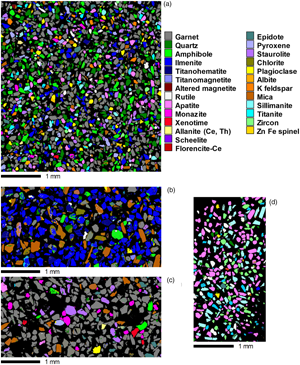Crossref Citations
This article has been cited by the following publications. This list is generated based on data provided by
Crossref.
Purohit, S.
Brooks, G.
Rhamdhani, M. A.
Pownceby, M. I.
and
Torpy, A.
2021.
Effect of impurity oxides on CWF (CaFe3O5) formation in lime magnetite pellets – part II: microstructural analysis and physical and mechanical testing.
Ironmaking & Steelmaking,
Vol. 48,
Issue. 3,
p.
313.
Setiawan, Agung
Rhamdhani, Muhammad Akbar
Pownceby, Mark I.
Webster, Nathan A. S.
and
Harjanto, Sri
2021.
Kinetics and Mechanisms of Carbothermic Reduction of Weathered Ilmenite Using Palm Kernel Shell Biomass.
Journal of Sustainable Metallurgy,
Vol. 7,
Issue. 4,
p.
1819.
Langendam, Andrew D.
Tomkins, Andrew G.
Evans, Katy A.
Wilson, Nicholas C.
MacRae, Colin M.
Stephen, Natasha R.
and
Torpy, Aaron
2021.
CHOS gas/fluid‐induced reduction in ureilites.
Meteoritics & Planetary Science,
Vol. 56,
Issue. 11,
p.
2062.
Torpy, Aaron
Fan, Rong
Wilson, Nicholas
MacRae, Colin
and
Austin, Peter
2021.
Quantifying Trace Element Variations in Chrysocolla by Clustering FEG-EPMA Hyperspectral Maps.
Microscopy and Microanalysis,
Vol. 27,
Issue. S1,
p.
1870.
Nunna, V.
Hapugoda, S.
Pownceby, M.I.
and
Sparrow, G.J.
2021.
Beneficiation of low-grade, goethite-rich iron ore using microwave-assisted magnetizing roasting.
Minerals Engineering,
Vol. 166,
Issue. ,
p.
106826.
Polavaram, Krishna C.
and
Garg, Nishant
2021.
High-fidelity and high-resolution phase mapping of granites via confocal Raman imaging.
Scientific Reports,
Vol. 11,
Issue. 1,
Rahman, Aminur
Pownceby, Mark I.
Tardio, James
Sparrow, Graham J.
Haque, Nawshad
and
Hasan, Fuad
2021.
Distribution, Separation and Characterisation of Valuable Heavy Minerals from the Brahmaputra River Basin, Kurigram District, Bangladesh.
Minerals,
Vol. 11,
Issue. 7,
p.
786.
Rahman, Md. Aminur
Davey, Kevin J.
Heyes, Graeme W.
Bruckard, Warren J.
Sparrow, Graham J.
Pownceby, Mark I.
Tardio, James
and
Zaman, Md. Nazim
2022.
Upgrading a Brahmaputra River sand from northern Bangladesh by flotation to produce a high-grade silica glass sand concentrate.
Mineral Processing and Extractive Metallurgy,
Vol. 131,
Issue. 4,
p.
330.
Wilson, Nick
McCulloch, Dougal G
Salek, Alan G
Cook, Brenton A
MacRae, Colin
Torpy, Aaron
and
Tomkins, Andrew G
2022.
Using an EPMA to Map Lonsdaleite in Ureilite Meteorites.
Microscopy and Microanalysis,
Vol. 28,
Issue. S1,
p.
618.
Torpy, A
McMahon, S
Anticev, J
MacRae, C M
Wilson, N C
and
Pownceby, M I
2022.
A Multi-Technique Database for Spectrum Identification in Luminescence and X-Ray Maps.
Microscopy and Microanalysis,
Vol. 28,
Issue. S1,
p.
638.
Rahman, M. Julleh Jalalur
Pownceby, M.I.
and
Rana, Md. Sohel
2022.
Distribution and characterization of heavy minerals in Meghna River sand deposits, Bangladesh.
Ore Geology Reviews,
Vol. 143,
Issue. ,
p.
104773.
Liu, Weihua
Mei, Yuan
Etschmann, Barbara
Glenn, Matthew
MacRae, Colin M.
Spinks, Sam C.
Ryan, Chris G.
Brugger, Joël
and
Paterson, David J.
2023.
Germanium speciation in experimental and natural sphalerite: Implications for critical metal enrichment in hydrothermal Zn-Pb ores.
Geochimica et Cosmochimica Acta,
Vol. 342,
Issue. ,
p.
198.
Sarker, Shuronjit Kumar
Pownceby, Mark I.
Bruckard, Warren
Haque, Nawshad
Bhuiyan, Muhammed
and
Pramanik, Biplob Kumar
2023.
Unlocking the potential of sulphide tailings: A comprehensive characterization study for critical mineral recovery.
Chemosphere,
Vol. 328,
Issue. ,
p.
138582.
Pownceby, Mark I.
McCallum, David A.
and
Bruckard, Warren J.
2023.
Automated and Quantitative Mineralogy Applied to Chromite Ore Characterization and Beneficiation.
Minerals,
Vol. 13,
Issue. 3,
p.
440.
